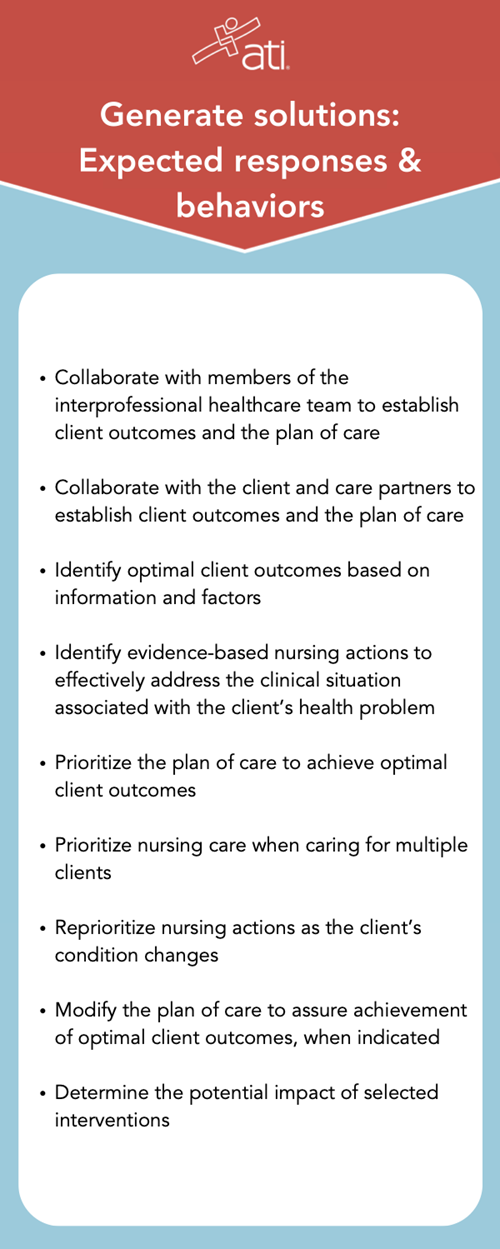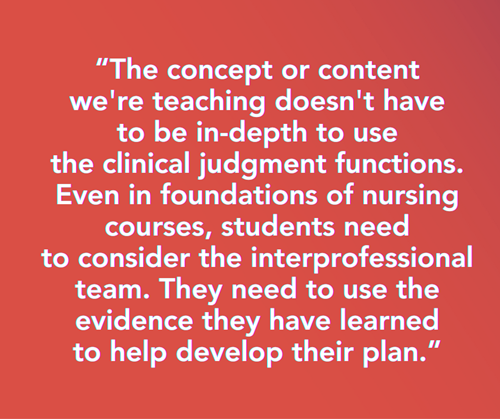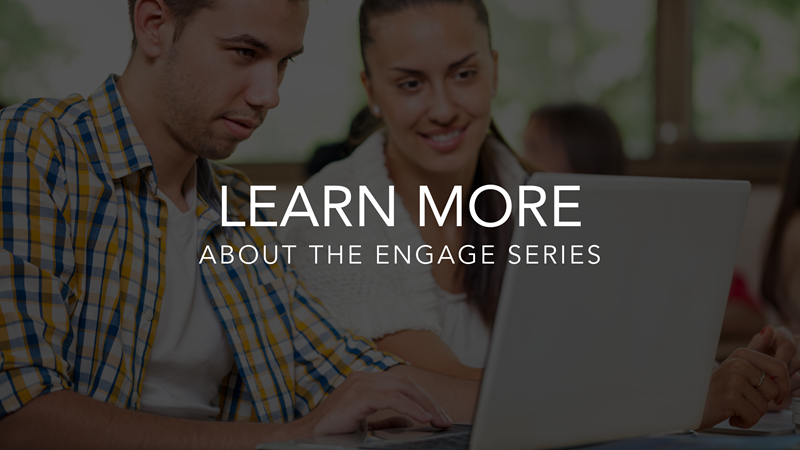Teaching nursing students to generate solutions
Fostering clinical judgment in nursing students using interactive resources that bring learning to life

As nursing students prepare for the NCLEX®, the development of a strong foundation in clinical judgment and decision making is a key to their success. This article is the 4th in an ATI Educator Blog series that explores the steps in the clinical judgment process. Each article shares strategies and recommendations from experienced faculty about techniques and resources that help students establish foundational clinical judgment.
(Missed the other articles in this series? Catch up!
Article 1: "Teach nursing students how to recognize cues using the Engage Series"
Article 2: "Teach nursing students to analyze cues using interactive tools"
Article 3: "Teaching nursing students how to prioritize hypotheses using interactive learning tools")
A closer look at the 4th clinical judgment function
Generate solutions is the fourth step in the Clinical Judgment Action Model (CJAM), which was developed by the National Council of State Boards of Nursing (NCSBN) to define the elements of the Clinical Judgment Measurement Model and the expected behaviors a nursing student needs to know and perform. As NCSBN has stated, the CJAM helps educators determine which areas of the clinical decision-making process a nursing student has a solid foundation in and identifies areas where improvement is needed.
To develop skill in generating solutions, the student should have:
- knowledge of health conditions
- knowledge of the treatments for health conditions
- knowledge of appropriate nursing interventions for health conditions
- the ability to prioritize the identified condition
- the ability to appropriately address the identified condition.
When considering what faculty need to identify as they assess students' ability to generate solutions, ATI Strategic Nursing Advisor Beth Cusatis Phillips, PhD, RN, CNE, CHSE, summarizes it this way: They need to determine whether the student can develop possible care options that are aligned with client needs.
To generate appropriate solutions for a client, the nurse identifies expected outcomes and uses hypotheses to describe interventions for the expected outcomes, Dr. Phillips said during a webinar presentation focused on developing clinical judgment using the Engage Series. (Find this video recording here.) The nurse needs to identify expected outcomes based on their prioritization of their hypotheses.
Expected responses and behaviors
 When generating solutions, certain responses and behaviors are expected. At first glance, the expectations to collaborate, identify and prioritize may seem high level for students who are early in their nursing program.
When generating solutions, certain responses and behaviors are expected. At first glance, the expectations to collaborate, identify and prioritize may seem high level for students who are early in their nursing program.“You might not think students are there just yet, but I think of it differently,” Dr. Phillips said. “The concept or content we're teaching doesn't have to be in depth in order to use the clinical judgment functions. Even in foundations of nursing courses, students need to consider the interprofessional team. They need to use the evidence they have learned to help develop their plan.”
She provided 2 examples within Engage Fundamentals: the Clinical Judgment and the Client Outcomes module, which contain video simulations in which a nursing student discovers a client on the floor.
“The student talks through the steps of the nursing process and the clinical judgment functions by spelling out the cues she recognized and analyzed just what they may mean,” Dr. Phillips said. “Then, prioritization kicks in.”
After the nurse assesses the client for injuries, the client needs to get off the floor and back into bed. The nurse needs to determine how that will occur. “In order to generate appropriate solutions, those first three steps in clinical judgment need to be performed correctly so that the client gets the best care possible,” Dr. Phillips said.
Another example of how Engage Fundamentals teaches students to generate solutions is included in the Vital Signs module, which covers body temperature, pulse, respirations, and blood pressure.
“When students learn how to take a blood pressure, they may feel uneasy because there are multiple things to do at one time,” Dr. Phillips said. “This module contains step-by-step videos showing both the one-step and the two-step method.”
Engage Fundamentals presents video, audio and text content that explains blood pressure evaluation methods. These include information on cuff selection and scenarios that prompt students to make decisions based on the data provided.
 While obtaining the blood pressure measurement of the simulated client, the student uses clinical judgment functions. For example, in the module, when the virtual student performs the two-step method, they observe that they no longer feel the brachial pulse at the 120 mark on the gauge (highlighted on the screen).
While obtaining the blood pressure measurement of the simulated client, the student uses clinical judgment functions. For example, in the module, when the virtual student performs the two-step method, they observe that they no longer feel the brachial pulse at the 120 mark on the gauge (highlighted on the screen).
“Students have to recognize that the standard adult cuff may be too big or too small for their client,” Dr. Phillips said. “They have to analyze which cuff they need based on the first cue, and then they have to locate the right cuff so that they get an accurate blood pressure. Finally, they generate solutions, making sure to always use the correct cuff on the client.”
The teaching continues as Engage Fundamentals prompts the student to document their decision process and provide communication about it. “Part of that plan needs to be making others aware too, so that the blood pressures are always accurate. Clear communication and documentation have to be part of the plan,” Dr. Phillips said.
“What does that mean? Does the student recognize that this is the point that the cuff is fully occluding the vessel?” Dr. Phillips asked. “If they understand that, then they know they need to pump up approximately 30 millimeters more so that they can move their stethoscope over to the artery to where they begin to hear the pulsation.”
Prioritization of care then presents as a decision for the learner. “If they heard pulsation immediately when they placed their stethoscope, that means they missed the actual systolic pressure,” Dr. Phillips said. “They need to deflate the cuff, wait 30 seconds, and try again. Once they obtain the accurate blood pressure, they may need to take action. But first, they generate solutions.”
While in any module in the Engage Series, students see and select from possible solutions. In the blood pressure measurement example, the student can select from several actions. “If the blood pressure is too low, they may need to lower the head of the bed and call the provider,” Dr. Phillips said. “If it's too high, they may need to recheck the BP or call the team.
“All of this clinical judgment takes place when taking a blood pressure. It seems pretty simple, but for that student, it's a lot to learn,” Dr. Phillips said. “Using the clinical judgment functions will help these novice students strengthen their decision-making abilities and will ensure their familiarity with the way the Next Generation NCLEX items are set up. That is a win-win.”
Engage is a foundation for student learning
Engage Fundamentals focuses on the foundational knowledge that nursing students must establish early in a program in order to be successful in their careers, and its impacts are long lasting. “Engage Fundamentals teaches basic competencies that nursing students will use for the rest of their careers,” Dr. Phillips said.
The entire Engage Series incorporates acquisition of knowledge, retention of knowledge, remediation of content, and review all in one place, she said. Engage solutions provide:
- active learning strategies
- interactive activities
- embedded quizzing
- summative review questions
- videos, skills, virtual applications, animations, 3D diagrams and more
- branching logic within the simulations, to enhance and deepen learning and comprehension of important concepts
- documentation skill building using EHR Tutor.
For further reading on interactive, technology-driven nursing education and textbook replacement, see these articles coauthored by Dr. Phillips:
Khalid, N., Zapparrata, N., Phillips, B.C. (In press, 2023). Theoretical underpinnings of technology-based interactive instruction. Teaching and Learning in Nursing. DOI: 10.1016/j.teln.2023.10.004
Phillips, B. C., Johnson, J., Khalid, N., Zapparrata, N. M., Albright, G. (2023). Benefits of an online interactive educational program over traditional textbooks. Nurse Educator. DOI: 10.1097/NNE.0000000000001398

